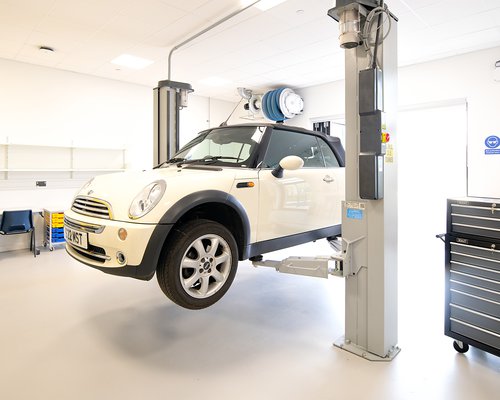What is CarboniCa?
Data-driven decision making with CarboniCa.
CarboniCa is our intelligent carbon reduction tool that measures whole life carbon emissions at a buildings design, construction and entire lifecycle.
CarboniCa cleverly highlights elements of the building that will result in higher carbon emissions and suggests lower-carbon alternatives for the client, designers and our supply chain, ensuring that considered, environmentally-friendly decisions based on meaningful and robust data can be made. It's part of our Intelligent Solutions approach, a strategy to support our customers find the solutions that matter to them - in this case, using digital tools and tried and tested solutions to reduce carbon from our communities.
Contact us about CarboniCa
Get in touchHow does it work?
CarboniCa is easy to use and robust in its methodology and background data.
It can be used by all industry stakeholders and enables systematic removal of whole life carbon from assets. You can see a small sample of a CarboniCa report here.
- It measures whole life carbon to the RICS professional standard, a feature that's critical to decarbonising the built environment
- It has been externally validated by Arup to the latest industry standards and is flexible to allow for the different project types being undertaken.
- It is a contractor-led tool, so it has been developed to be aligned to construction projects and robust in it's ability to measure what we do as a business
- It is an intelligent tool, and automatically suggests ways our team and customers can reduce carbon in the design of the asset and procurement of materials
- It has a significant and agile programme of R&D with key focal areas of: Digital asset interoperability, Building services embodied carbon, Data uncertainty modelling, Circular economy and Machine learning and AI
Feedback on the use of CarboniCa
It is amongst the most sophisticated and complete tools that I have seen, which nicely balances complexity and simplicity for most use cases.
Senior Consultant, Arup
If we are to cut carbon from constructing and using buildings we need set emissions targets and measure outcomes. An effective tool like CarboniCa for forecasting and managing whole life carbon is therefore essential.
As co-sponsor of the Circular Twin research project, we were enabled in our decision making by the insight CarboniCa provided into the relative benefits of design options and materials selection on the whole lifecycle carbon emissions of each choice.
Chris Clarke, Performance and Improvement Director, Scape
How is it unique to the market?

Developed from the ground up as a project tool and something our teams and customers can use without in depth training or specialist knowledge

It asks simple questions related to information our project teams have access to – it is not necessary to enter materials one-by-one

It doesn’t rely exclusively on a BIM plug-in and it has a distinct numbering convention and is cloud-based which enables digital asset interoperability

Allows us to respond quickly to emerging UK-specific guidance around carbon assessments, circular economy, and our grassroots supply chain engagement

Is one of the few tools entirely aligned with the RICS Whole life carbon assessments for the built environment Professional Statement.
Carbonica in action on our projects
Over 350 tonnes of carbon removed from University of Birmingham (UoB) project
The Molecular Sciences Building for UoB, is the new home for the School of Chemistry, as well as a smaller cohort from the School of Geography, Earth and Environmental Sciences (GEES). The building will strengthen the University’s research capabilities in the chemical, environmental and biomolecular sciences, fostering an environment for carrying out world class research. The goal was for the building to achieve BREEAM Excellent standard, a challenge considering the energy intensively used for laboratory and research spaces.
The use of CarboniCa – ensured we could achieve this. We also collaborated with sustainability specialists KLH to explore ways to reduce the carbon output of this project and to help validate our carbon savings generated from CarboniCa. Through the support of CarboniCa, KLH and various stakeholders, we saved over 350T of carbon which included replacement of metal ceiling tiles with plasterboard margins and changing from a pile foundation solution to a raft solution. Changing from the piled foundation option also generated a cost saving for the client of £170k whilst ensuring vibrations from the neighbouring train line would not travel into the building.
CarboniCa was new to us – it picks up the carbon impact of construction cycle and whole life cost. I’ve been really impressed with how sustainability has been managed through construction and what’s been good is the regular reports coming out of CarboniCa to back up some of those aspirations for the project. Our Net Zero Carbon targets mean we can’t go backwards with any building we build, we need to make sure every build takes us in the right direction on that improvement trajectory. So data, statistics and real time information is helpful because it brings people with us and makes sure we evidence that we are making the right investment decisions. It has been really useful!
Trevor Payne, Director of Estates, University of Birmingham
Achieving our customers goal to deliver the first net-zero carbon building
Buntingford First School is being in line with Hertfordshire County Council’s sustainability strategy and ambition to be carbon neutral by 2030. The school is the first Net-Zero Carbon building for the council and is being designed to Passivhaus principles to improve air quality, reduce carbon emissions and lower its energy running costs.
To help achieve this, the project team used CarboniCa to identify a number of carbon savings, which included, minimising the amount of concrete in the foundations by reducing the number of piles and depth of the ground beam design, as well as mixing 50% of the concrete with GGBS, a low carbon concrete alternative. The team also opted to use a timber frame in the design and HVO fuel was used on site during it's construction.
The solutions delivered by the team amounted to a 203 tonne reduction in carbon, with Councillor Caroline Clapper from Hertfordshire County Council noting that "this will be the gold standard for school building going forward."
CarboniCa brings savings that are lower than the required Passivhaus standard
Trent View College is a Passivhaus SEND school project in Scunthorpe, was deisgned by HLM Architects and delivered for the Department for Education (DfE) and Wellspring Academy Trust.
The school has a number of facilities for 16-19 year-olds, which are traditionally high in their carbon outputs including a motor vehicle workshop and a hydrotherapy pool. However the team worked to ensure that the building was delivered to the required standards of best practice energy efficiency measures and a very low heating demand per square metre.
The team worked with our supply chain to ensure that the insulation and air tightness was as rigorous as possible without wasting material. By doing this in-conjunction with CarboniCa, the heating requirement was reduced from 15 to 14kWh/m2/year by altering the design choices of wall and roof insulation. With this, the project team have reduced the operational energy for space heating even lower than the required Passivhaus standard resulting in a further saving of 80 tonnes of carbon over the schools lifetime.
Reviewing the data from CarboniCa and switching frames saved 177 tonnes of carbon
We worked collaboratively with our supply chain partner Sigmat Limited on our Victoria Road, where we're creating 42 residential flats for Brighton & Hove Council, to find alternative solutions to the building's structural frame, using CarboniCa to review the carbon credentials of the given options.
By utilising a lightweight steel frame rather than a concrete one, CarboniCa measured that there would be a 177 tonne saving in embodied carbon at practical completion.
Working with our supply chain to remove over 2,000 tonnes of carbon
Alongside the data from CarboniCa we incorporated the skills of our supply chain partners to reduce the impact across the £75m Wirral Growth Hub project in Birkenhead.
Reductions including altering the foundations, the team reduced the pile diameter, changed the concrete mix to increase cement replacement, and sourced lower carbon rebar made from scrap metal. Carbon reduction is a team effort and by sharing skills, best practice and data we can achieve some great results. We'd like to thank our supply chain partners for their support; Chartrange, Hy-Ten, Van Elle, Murraywood Construction, Hanson and Leach.
Constructing an exciting, low carbon urban innovation district
Our team is working with Howard Group in Sawston, Cambridgeshire to create low carbon, life science space in the golden triangle. Demand is at an all time high, in June 2022 there was a need for 1.2 million square feet of high-quality space. The requirement to build sustainably is a high consideration for investors and tenants in the sector as they need space that reduces climate impact.
By working with the team at the pre-construction stage our project team, project management consultants - 3PM and our supply chain were able to bring in solutions like CarboniCa and advise on the changes to the design that would have the most impact on carbon reduction. Example savings included - changing the SFS to a timber SIPs wrap system, removing 104 tCO₂e, omitting the roof screed removing 40 tCO₂e, by adding GGBS to the concrete mix - 24 tCO₂e was saved and switching concrete suppliers to the local depot in Sawston saving 32.5 tCO₂e. What's more, travel distances of our supply chain are now being added to the RIBA Stage 5 Assessment and accurate tracking at the time led to a 36.7 kgCO2e/m² reduction.
Read more about this project in this digital brochure.
What Morgan Sindall are doing is industry leading in demonstrating the impact of the embodied and operational carbon budgets on their projects.
Morgan Sindall recently presented to 3PM and the Howard Group, the as-designed embodied carbon outputs of their Lab-Enabled development in Cambridge. Their intelligent carbon calculator CarboniCa, was able to retrospectively quantify the client’s baseline and is able to swap components enabling carbon value judgements to be made as the design develops.
Patrick Watson, Founding Partner, 3PM
About CarboniCa
Click to readContact us about CarboniCa
Get in touch





















